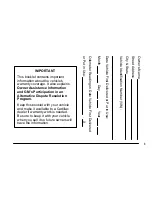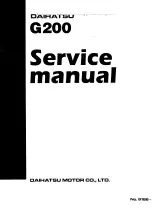
Protecting Infants
Child Seat Type
Only a rear-facing child seat
provides proper support for a
baby's head, neck, and back.
Infants up to about one year of
age must be restrained in a
rear-facing child seat.
Two types of seats may be used:
a seat designed exclusively for
infants, or a convertible seat used
in the rear-facing reclining mode.
We recommend that an infant be
restrained in a rear-facing child
seat until the infant reaches the
seat maker's weight or height
limit and is able to sit up without
support.
Rear-Facing Child Seat
Placement
In this vehicle, a rear-facing child
seat can be placed in any seating
position in the back seat, but not
in the front seat.
Never put a rear-facing child
seat in the front seat.
If the
passenger's airbag inflates, it can
hit the back of the child seat with
enough force to kill or seriously
injure an infant. If an infant must
be closely watched, we
recommend that another adult sit
in the back seat with the baby.
Do not put a rear-facing child
seat in a forward-facing position.
If placed facing forward, an infant
could be very seriously injured
during a frontal collision.
Driver and Passenger Safety
Placing a rear-facing child seat
in the front seat can result in
serious injury or death if the
airbags inflate.
Always place a rear-facing child
seat in the back seat, not the
front.
Summary of Contents for 2000 Passport
Page 49: ...46...
Page 55: ...52...
Page 89: ...86...
Page 97: ...94...
Page 117: ...114...
Page 153: ...150...
Page 193: ...190...
Page 235: ...Cooling System Air Conditionin g Clutch Technical Data...
Page 238: ...Rear Axle Front Axle 4WD Model Wheels and Tires Shift on the Fl y System TechnicalData...
Page 240: ...Fuse Box Instrument Panel Technical Data...
Page 241: ...Fuse Box Engine Compartment Technical Data...
Page 242: ...Light Bulbs Dimensions and Weights Note GVWR Gross Vehicle Weight Rating Technical Data...
Page 243: ...240...
Page 246: ...243...
















































